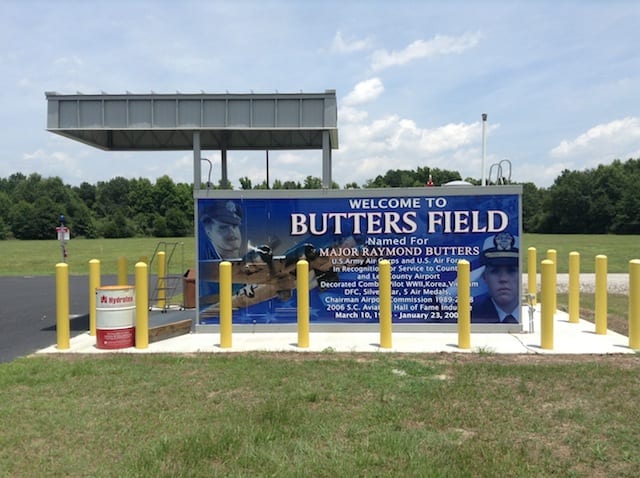U-Fuel has installed one of its “Box” fuel stations at the Lee County-Butters Field Airport (52J) in Bishopville, S.C. The airport took advantage of the new installation to honor the airport’s namesake.
 The large flat surfaces of U-Fuel’s recently-patented Box system are ideal for graphics, and the airport took advantage of this, company officials noted. On one side, a picture of the airport’s namesake, World War II B-17 pilot Major Raymond Butters, appears along with a list of his citations. On the other side appears a promotion for the South Carolina Cotton Museum and Lee County Veteran’s Museum located in nearby Bishopville.
The large flat surfaces of U-Fuel’s recently-patented Box system are ideal for graphics, and the airport took advantage of this, company officials noted. On one side, a picture of the airport’s namesake, World War II B-17 pilot Major Raymond Butters, appears along with a list of his citations. On the other side appears a promotion for the South Carolina Cotton Museum and Lee County Veteran’s Museum located in nearby Bishopville.
 “An airport without fuel is at a disadvantage for based and transient traffic,” noted George Roberts, Lee County Airport manager. “The U-Fuel systems gives our customers 24 hour access to fuel without an employee overhead. Our county officials like the facility over a truck system with its limited hours of service, the manpower needed for a trained driver and the liability associated with a fuel truck. Furthermore, the U-Fuel system exceeds the requirement for a complex and costly Storm Water Emergency Plan. The combined advantages of the U-Fuel system makes my job as an airport manager easier.”
“An airport without fuel is at a disadvantage for based and transient traffic,” noted George Roberts, Lee County Airport manager. “The U-Fuel systems gives our customers 24 hour access to fuel without an employee overhead. Our county officials like the facility over a truck system with its limited hours of service, the manpower needed for a trained driver and the liability associated with a fuel truck. Furthermore, the U-Fuel system exceeds the requirement for a complex and costly Storm Water Emergency Plan. The combined advantages of the U-Fuel system makes my job as an airport manager easier.”
Introduced in 2011, U-Fuel’s patented Box systems place all critical components and the fuel tank within a sfire-resistant panel enclosure. Pre-engineered and pre-fabricated, these systems can be trucked to an airport and installed within a few days, according to company officials. They are available as single- or two-product systems with tank capacities from 1,000-10,000 gallons.
For more information: UFuel.com
Pictured above: Grady Snowden of Florence, S.C, refuels a 1946 Luscombe 8A at Butters Field while on a cross country training flight. Snowden, a Citadel Military College student, was receiving instruction for a taildragger endorsement to his pilot’s license. Looking on is Linda Butters, Lee County Airport Commissioner and widow of Raymond Butters, after whom the airport is named.
At a cost of about $53,000 for a single tank system the cost is low enough for many municipalities to purchase. These systems, or ones like them, would be perfect for adding mogas to existing fuel operations. In the event that Swift fuel 100SF or the GAMI G100, 100 grade fuel replacements become available then these tank systems again, would allow for rapid deployment of these new fuels.
Very true. One of the many myths of aviation is that fuel systems must all cost $150,000 or more, far from today’s reality.